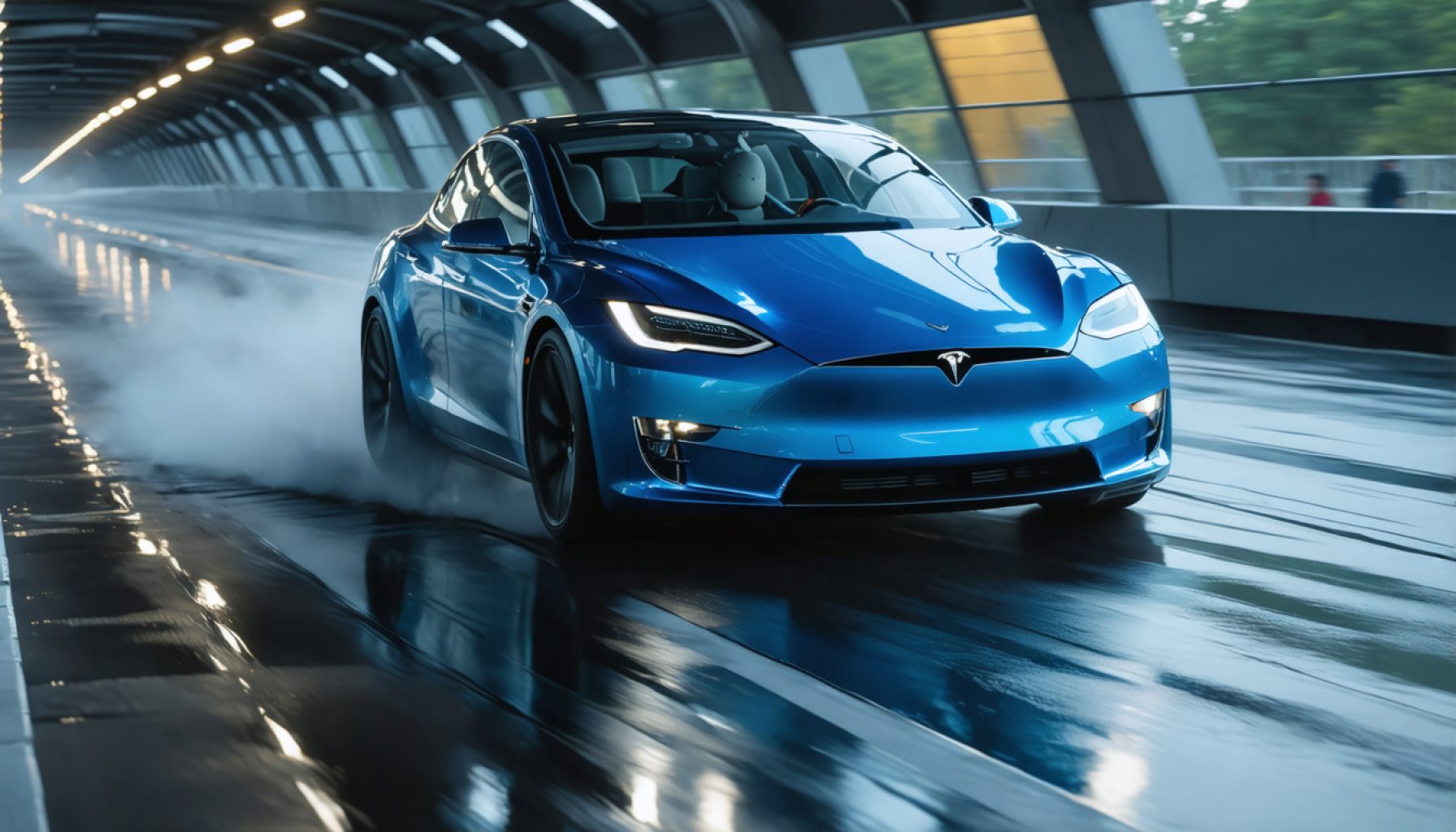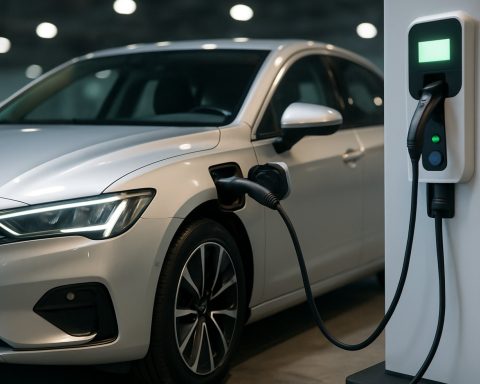- Over the past decade, Tesla has evolved from a startup to a leader in the electric vehicle industry, significantly increasing its value.
- The company’s focus extends beyond EVs to redefining transportation, with initiatives such as autonomous vehicle projects.
- Tesla’s Cybercab, a robotaxi service, is set to launch in Austin, Texas, potentially revolutionizing urban mobility and significantly boosting the company’s market value.
- Despite robust growth, challenges include Elon Musk’s controversial public presence, potential geopolitical market impact, and delays in ambitious timelines.
- Competition remains strong, with rivals like Waymo possessing early-mover advantages in autonomous transport.
- Tesla’s future hinges on accessibility and innovation, with upcoming affordable models aiming to broaden market appeal and redefine mobility perception.
A decade can feel fleeting, but within those ten years, Tesla transformed from a promising startup to a revolutionary force steering the electric vehicle landscape. An investment of $10,000 in Tesla a decade ago would now swell into $215,600, reflecting the dizzying growth under Elon Musk’s unorthodox leadership. Tesla’s narrative, however, transcends mere electric vehicles; it’s about redefining transportation itself.
Tesla’s emergence as a frontrunner in the U.S. EV market signals a seismic shift, one that has left traditional automakers scrambling to modernize. Muscling the cost of production below $35,000 per vehicle, Tesla has endeared itself to consumers seeking innovation without the luxury price tag. Yet, the true test of its technological prowess looms on the horizon—the introduction of its autonomous vehicle venture, the Cybercab.
Conceived as a futuristic robotaxi service, the Cybercab represents Tesla’s bold stride into autonomy and shared mobility. The company has earmarked Austin, Texas, for its eagerly anticipated launch, signaling a pivotal moment that could redefine urban transportation landscapes. According to ARK Invest, this venture could catapult Tesla’s worth to unprecedented heights, predicting that robotaxis could encompass a staggering 88% of Tesla’s enterprise value by 2029.
To proponents of Musk’s vision, this is more than speculation. It’s a potential reality within grasp, drawing parallels to the leap of faith early believers took with the company’s electric sedan. Yet the path is fraught with challenges. Tesla’s timeline for delivery has proved ambitious before; 2019’s promise of a million-robotaxi fleet remains deferred. Rivals like Waymo have been operational for half a decade, gaining critical early-mover advantages.
Moreover, Musk’s polarizing presence on the global stage—marked by controversial actions and comments—casts a shadow over Tesla’s brand, particularly in markets sensitive to geopolitical affiliations. The dip in European sales is a stark reminder of the potential fragility of its market position.
The broader market awaits tangible results from Tesla’s ventures. Recent figures underscore the flux—production exceeding deliveries and the strategic pivot to new models, such as the eagerly awaited Model Y. As enthusiasts and investors eagerly anticipate this launch, Tesla’s future hinges not just on selling vehicles but on embedding itself within the fabric of what mobility means.
As 2025 approaches, a new, more affordable model promises to democratize Tesla’s appeal further, fostering curiosity among skeptics and fueling hope among loyal followers. But beneath the fanfare lies an undeniable truth: the world of Tesla isn’t just about electric cars. It’s about a radical shift in movement, a daring leap into the future, predicated on a delicate balance between innovation and execution. Whether Tesla’s gambit succeeds or stumbles, the coming years will indelibly influence the landscape of global transport and how society envisions the road ahead.
Unveiling the Future: How Tesla’s Bold Moves Could Transform Global Transportation
Tesla’s Decade of Disruption: More Than Meets the Eye
Over the past decade, Tesla has undoubtedly reshaped the electric vehicle (EV) landscape. Yet, beyond the headlines of its impressive stock performance and Elon Musk’s charismatic leadership, there are several facets of Tesla’s journey that deserve more attention. Tesla is not just reinventing how vehicles are powered; it’s redefining the concept of transportation.
Autonomy and Shared Mobility: The Cybercab Revolution
Tesla’s ambitious plans with the Cybercab—a futuristic robotaxi service—highlight a significant pivot towards shared, autonomous mobility. Scheduled to debut in Austin, Texas, this development could have profound implications for urban transportation. Here’s why:
– Market Potential: ARK Invest projects that the robotaxi venture could make up 88% of Tesla’s enterprise value by 2029. This suggests a massive market opportunity that extends beyond traditional car sales.
– Technological Challenges: While the autonomous vehicle industry remains fraught with regulatory and technological hurdles, Tesla’s focus on real-world AI solutions aims to address these head-on.
– Competition Landscape: Companies like Waymo already have a head start, but Tesla’s vertically integrated approach—championing both hardware and software innovation—could set it apart once the technology matures.
Challenges with Timelines and Perceptions
Historically, Tesla has had ambitious timelines, often missing delivery deadlines. The same holds true for the promised robotaxi fleet that was announced for 2019 but remains unrealized. Here’s where potential drawbacks lie:
– Timely Execution: Meeting project deadlines will be critical to maintaining investor confidence and gaining traction against established competitors in the autonomous space.
– Brand Vulnerability: Elon Musk’s controversial public behavior has impacted Tesla’s brand, particularly in markets sensitive to political and social issues.
Strategic Product Expansion
With production often exceeding deliveries, Tesla’s strategic pivot to new models like the Model Y underpins its approach to market expansion:
– Model Y Launch: Highly anticipated by enthusiasts, this model could enhance Tesla’s foothold in the compact SUV market, targeting increasing consumer demand for versatile vehicles.
– Affordable Model by 2025: A new vehicle priced for broader affordability is in the pipeline, aiming to democratize Tesla’s appeal and potentially capturing a significant share of the lower-priced EV market.
Industry Trends and Predictions
As Tesla continues its bold strides, several industry trends and market forecasts highlight where the company—and the EV market—might be heading:
– EV Market Growth: The global electric vehicle market is expected to grow at a compound annual growth rate (CAGR) of around 21.7% from 2021 to 2030, per Allied Market Research.
– Policy Influence: Governments worldwide are implementing stricter emissions regulations and offering incentives for EV adoption, which could accelerate Tesla’s growth.
Quick Tips for Potential Tesla Investors
1. Diversify Your Portfolio: Given Tesla’s volatility, it may be wise to hold Tesla stocks as part of a broader investment strategy rather than a standalone bet.
2. Stay Informed on Regulatory Changes: Keep an eye on evolving laws impacting autonomous vehicles, as these could significantly influence Tesla’s business outlook.
3. Follow Technological Advancements: Understanding innovation in battery technologies and autonomous driving can provide insights into Tesla’s future capabilities.
For more insights into EV advancements and Tesla’s strategic developments, visit Tesla.
In conclusion, Tesla’s trajectory speaks to transformative possibilities in global transportation. While challenges persist, its ventures in autonomy, shared mobility, and affordable EV models reveal an ecosystem geared towards a comprehensive vision of future mobility. Balancing bold innovation with effective execution will be key to cementing Tesla’s place in the annals of automotive history.







